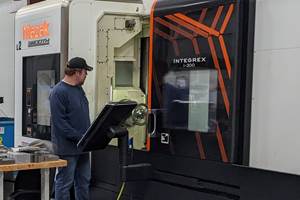Vertical Machining Center Helps Job Shop Stay Competitive
This shop has applied this vertical machining center to help with its core business of prototype and small runs.
Share






Herrin Enterprises (Buda, Texas) is a family-owned and operated job shop, which may not sound too out of the ordinary. But Herrin, as it enters its third generation, remains successful where many shops have struggled.
Herrin employs ten people and runs one shift per day. Known for prototype and small run jobs, Herrin’s diversified customer base includes customers in the oil refinery, medical, plastic and semi-conductor industries. As the economy has changed, particularly during the past year, this job shop has sought to maximize this niche of its business.
In 2002, Keith Herrin, owner and operator of the company, took a hard look at his business and its future. In considering the economy and the changing climate of manufacturing, he determined that the company’s machine tool needs as identified in years past were no longer relevant. He needed a machine that could help him broaden the scope of his business and reinforce his core business of prototype and small runs.
With years of successful use of Mori Seiki lathes under his belt, Mr. Herrin turned to Mori Seiki. “We were looking for a vertical machining center that was more exotic, that could help us solidify our niche as a top small-run, prototype shop,” says Mr. Herrin. “The technology behind the NV5000 made it the obvious choice, and its computer numerical control (CNC) was attractive to us.”
Prior to the NV5000, Herrin owned several Mori Seiki lathes—the SL-2, SL-3, TL-3 and TL-5—that were all part of the company’s first equipment purchase in 1980. Five years later, Herrin also purchased the SL-303A/1500 and an SL-150.
“The history was there with Mori Seiki, so it was logical for us to look at them first,” says Mr. Herrin. “We spoke to JRP Machinery (Mori’s distributor in Texas), and we were sold on the idea of the NV5000.” Mr. Herrin was particularly impressed with the 12,000-rpm main spindle and 1,654-ipm rapid traverse rate.
Another feature that attracted Herrin included the user-friendly MAPPS operator panel that is the interface to the NV5000. MAPPS is completely solid state, which is said to make it rugged and reliable. Options for MAPPS, such as CAPS-NET for remote process logging and CAPS-DSN for program transfer, connect to the user factory’s Ethernet network.
The NV5000 was introduced at Herrin in the spring of 2002. Availability and speed of delivery were key in the decision to purchase.
“Once we determined that the NV5000 was the way to go, we issued the purchase order within 10 days,” says Mr. Herrin. “In addition to the machine’s capabilities, the fact that the NV5000 was available immediately was an important factor in our decision.”
In fact, Herrin’s Mori Seiki was delivered in just 9 days, traveling from Los Angeles to Austin. “We have always had a good relationship with Mori Seiki and JRP, so it was no surprise to us that the machine was delivered and installed so quickly,” says Mr. Herrin.
Installation went smoothly; in fact, the machine was installed in less than a day. “Mr. Herrin is one of the first users of the NV5000, so we really wanted to get the machine in his shop as soon as possible,” says Ben Richey, sales engineer for JRP Machinery. “We knew he’d start using it just as fast as we could deliver it.”
Representatives from JRP were also on hand for training, and as predicted, Mr. Herrin wasted no time in getting the machine going on its first job. JRP also provided follow-up training for the Herrin operators.
Herrin’s first assignment for the NV5000 was a small-run prototype for oil rig positioning equipment. According to the company, the NV5000 handled the 6 by 6 by 6.5-inch stainless steel part beautifully, and it has continued to excel on the shop floor in the time Herrin has had the machine. Since that first job, the company has successfully run more than 25 jobs on the NV5000.
“We’ve been around for many years, and we are continually looking for ways to build business, especially during these tough times,” says Mr. Herrin. “By incorporating the NV5000 and the service and support that comes with a Mori Seiki purchase, we have another advantage over our competition.”
When asked if he would consider purchasing another Mori Seiki machine, Mr. Herrin does not hesitate. “Absolutely. We’ve been nothing but pleased so far. More importantly, I’m confident in the reliability of the machine as we move forward.”
Related Content
5 Tips for Running a Profitable Aerospace Shop
Aerospace machining is a demanding and competitive sector of manufacturing, but this shop demonstrates five ways to find aerospace success.
Read MoreInverted Milling Offers Power in a Compact Machine
To compete in terms of stability and horsepower, Modig’s recent IM-8 mill takes an unorthodox approach: positioning the spindle at the bottom of the work area.
Read MoreThe Benefits of In-House Toolmaking
The addition of two larger gantry routers has enabled a maker of rubber belting products to produce more tooling in-house, reducing lead times and costs for itself and its sister facilities.
Read MoreHow a Custom ERP System Drives Automation in Large-Format Machining
Part of Major Tool’s 52,000 square-foot building expansion includes the installation of this new Waldrich Coburg Taurus 30 vertical machining center.
Read MoreRead Next
AMRs Are Moving Into Manufacturing: 4 Considerations for Implementation
AMRs can provide a flexible, easy-to-use automation platform so long as manufacturers choose a suitable task and prepare their facilities.
Read MoreMachine Shop MBA
Making Chips and Modern Machine Shop are teaming up for a new podcast series called Machine Shop MBA—designed to help manufacturers measure their success against the industry’s best. Through the lens of the Top Shops benchmarking program, the series explores the KPIs that set high-performing shops apart, from machine utilization and first-pass yield to employee engagement and revenue per employee.
Read More



















